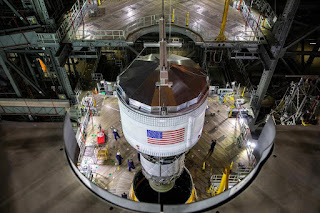Space Launch System
NASA created and constructed the Space Launch System (SLS), a potent rocket for deep space missions, including manned trips to Mars and beyond. The SLS was first launched on November 16, 2022.
The SLS rocket, the most potent launch vehicle NASA has ever produced, was developed to be versatile and adaptable to a variety of mission configurations. The core stage and the boosters make up its two primary parts.
 |
| Credit :- Wikipedia |
Steps To Launch SLS
The SLS rocket's largest component and primary source of thrust during launch is the core stage. Four RS-25 engines—the same engines that powered the Space Shuttle—give it a height of more than 200 feet. The SLS is the most potent rocket NASA has ever produced thanks to these engines, which provide a combined thrust of 2 million pounds.
The boosters, which are solid rocket motors, contribute thrust to the launch. Two solid rocket boosters from the Space Shuttle are converted into five-segment boosters for the SLS. Each booster adds 3.6 million pounds of thrust and stands over 17 floors tall.
What Are The Technical Components Of The SLS ?
- Configuration :- The SLS is a two-stage rocket vehicle that has several boosters, a core stage, a second stage, and other parts.
- Payload capacity :- The SLS is designed to be a heavy-lift launch vehicle, capable of carrying payloads of up to 130 metric tons (143 tons) to low Earth orbit (LEO), and up to 45 metric tons (50 tons) to trans-lunar injection (TLI).
- Core stage :- The SLS's core stage, which is 65 metres (212 ft) tall and has an 8.4-meter (27.6-foot) diameter, is the rocket's biggest part. Four RS-25 engines, which were also used on the Space Shuttle, are used to power the core stage.
- Second stage :- The second stage of the SLS is powered by the J-2X engine, which is an advanced liquid-fueled engine that can be restarted multiple times. The second stage is designed to provide the final push needed to send the rocket and its payload on a trajectory to the Moon or other deep space destinations.
- Boosters :- Two five-segment solid rocket boosters, which are used by the SLS, contribute thrust to the rocket's initial stage of ascent. These boosters are a descendent of the Space Shuttle's solid rocket boosters.
- Guidance and control systems :- The SLS is equipped with advanced guidance and control systems, including an inertial measurement unit, a flight computer, and a range safety system. These systems help to ensure that the rocket stays on course and operates safely throughout the launch process.
Importance Of SLS For NASA
A key element of NASA's plans for upcoming space exploration is the SLS. The Orion spacecraft, which is intended to transport men to distant locations like the Moon and Mars, will be launched using it. Other robotic projects, including the Europa Clipper mission, which will explore Jupiter's icy moon, will also be launched using the SLS.
For NASA, the SLS program's development has been a significant project that has been fraught with financial and technological difficulties. Despite these obstacles, NASA is dedicated to creating the SLS and carrying on with its solar system mission.
What are the key challenges that NASA has faced in developing the SLS?
NASA has faced several key challenges in developing the Space Launch System (SLS).
- Technical challenges :- Propulsion, materials science, avionics, guidance and control systems, and other technological issues must be resolved in order to develop a rocket as sophisticated as the SLS. In particular, creating a rocket capable of lifting weighty payloads outside of Earth orbit necessitates cutting-edge propulsion technology and novel rocket design strategies.
- Budgetary constraints :- Developing the SLS has been a costly endeavor, with estimated development costs of over $18 billion as of 2021. NASA has faced budgetary constraints and funding shortfalls throughout the program's history, which has led to delays and setbacks in development.
- Supply chain issues :- Components for the SLS programme are supplied from a huge and complicated supply chain that includes a variety of vendors and suppliers. This may result in delays and problems with quality control, as well as logistical difficulties in coordinating and integrating the numerous parts.
- Political and institutional challenges :- The political and institutional climate in which NASA functions can make it difficult to secure the necessary funding and resources for the SLS programme. For long-term programmes like the SLS, in particular, shifting budgetary objectives and political priorities can create uncertainty and instability.
- Safety concerns :- Developing a rocket as powerful and complex as the SLS requires rigorous safety testing and engineering to ensure that the rocket can operate safely and reliably. Any safety issues or setbacks in development can have serious consequences for human safety and mission success.
Unique Features Of The SLS And Its Ability
The SLS's versatility in terms of configuration for various missions is one of its distinctive qualities. Depending on the payload and mission needs, it can be manufactured in a variety of configurations. For lesser payloads, the SLS can be constructed with a single core stage and a group of boosters; for bigger payloads, it can be constructed with two core stages and four boosters.
The SLS has been designed to carry a range of payloads, including crewed spacecraft, robotic missions, and cargo. The rocket is capable of carrying a payload of up to 130 metric tons, making it the largest and most powerful rocket ever built.
Conclusion
In conclusion, the Space Launch System is a powerful rocket designed to take humans and payloads to deep space destinations. With its ability to be configured for different missions and its impressive payload capacity, the SLS is poised to be an important component of future space exploration efforts.


